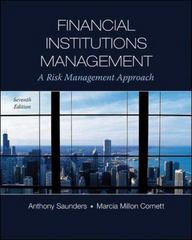Question
Question 1 info: Rack Industries (Rack) a manufacturing company, wants to build a new plant. It offers to pay Cosmo Construction 5 million dollars to
Question 1 info: Rack Industries (Rack) a manufacturing company, wants to build a new plant. It offers to pay Cosmo Construction 5 million dollars to build the plant. Rack estimates, based on projected demand for its product, that the net present value of the plant upon completion would be 5.5 million. Currently, the cost to Cosmo of building the plant will be 4.6 million, but both parties know that there is a chance that prices of some key construction materials will rise after the contract is signed, making the cost of building the plant 5.6 million. Assume that the chance of this happening is low enough that Cosmo is still willing to accept the contract. Finally, assume that contracts are enforced with expectation damages.
Question 2 info: Assume that Cosmo is a wholly owned subsidiary of Rack, that is, they are both run by the same management. In conjunction with building the plant, Rack can make a number of investments prior to the start of construction to increase the potential value of the completed plant. The possibilities for such investment are given below:
| If Rack invests an additional: | The value of the plant will be: |
| 0 | 5.5 million |
| .15 million | 5.68 million |
| .16 million | 5.7 million |
| .20 million | 5.75 million |
Also, the Rack/Cosmo management knows that construction costs for its Cosmo subsidiary may rise. There is a 70% chance that the cost of building the plant will be 4.6 million, and a 30% chance that it will be 5.8 million.
Assume that the goal of the Rack/Cosmo Cities management is to maximize expected profit (value of plant minus expected cost of building and additional investment). Note that they have four levels of additional prior investment they can choose (none, .1, .15, or .2 million), but must make this choice before they know the cost of construction. However, after making the prior investments, they may still decide not to build the plant at all if construction costs turn out to be high but will then lose the value of any prior investments, because these investments have to be made before construction starts. So, Rack/Cosmo has two decision to make: the level or prior investment, and the decision of whether or not to build the plant once construction costs are known.
Question 3: Assume all the facts are the same as in question 2, except assume once again, as in question 1, that Cosmo construction is a separate company from Rack, and has signed a contract to do the construction project for a payment (in advance) of 5.0 million.
Suppose both parties know that the remedy for Rack in case of a breach will be a payment equal to the value of the unbuilt plant, where that value is determined based on whatever reliance investments Rack might have made (For example, if Rack invested an additional .15 beyond the 5.0 million it paid Cosmo, then in the event of breach Cosmo would have to pay 5.68 million to Rack that is, return the 5 million it got from Rack plus the .15 that Rack invested in reliance plus .53 million that Rack expected in profit). Under these circumstances, what level of reliance investment would Rack undertake? If the costs turned out to be high, would Cosmo breach or perform? Explain.
A large home furnishings store hired a commercial nursery put in decorative trees, bushes, and flowers around the store and its parking lot, promising to pay $10,000 upon completion of the job. After signing the contract, the store paid another contractor $5000 to tear up asphalt and put in dirt to prepare for the planting. However, when the time came to plant, the commercial nursery said that it could not do this beautification project, because disease and bad weather had destroyed to much of its stock for it to keep all of its commitments. The store sued the nursery for breach of contract. Among other things, it claimed that the nurserys breach of contract would cause the store to miss out on higher profits in the future because the increased beauty of the stores exterior would have attracted more customers and increased sales.
a. If the court gave the plaintiff in this case an award of specific performance, what would that mean?
b. What major problem would face the court if it wanted to impose expectation damages in this case?
c. Why is it reasonable to argue that the net present value of the additional profits that the store would have earned if the nursery had performed was at least $10,000?
d. If the court order the nursery to pay reliance damages in this case, what would the nursery have to pay?
Step by Step Solution
There are 3 Steps involved in it
Step: 1

Get Instant Access to Expert-Tailored Solutions
See step-by-step solutions with expert insights and AI powered tools for academic success
Step: 2

Step: 3

Ace Your Homework with AI
Get the answers you need in no time with our AI-driven, step-by-step assistance
Get Started


